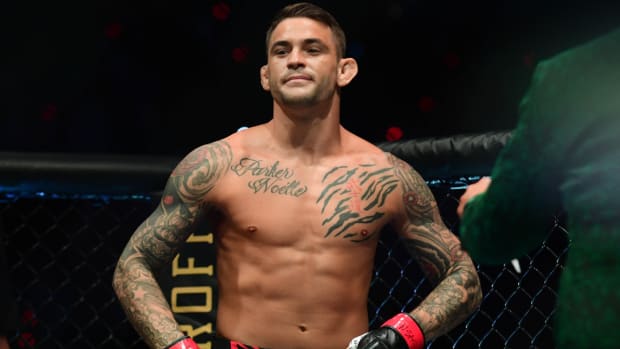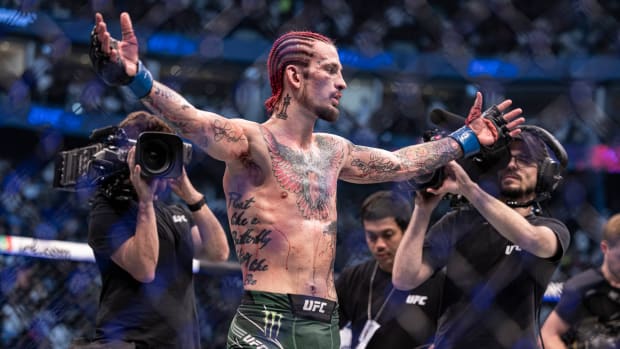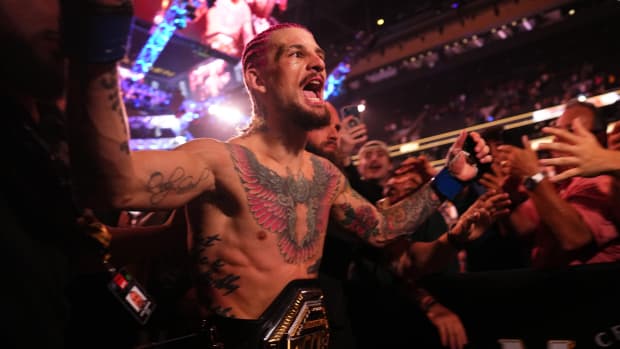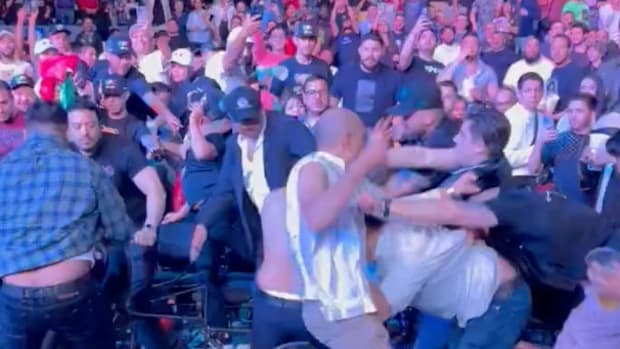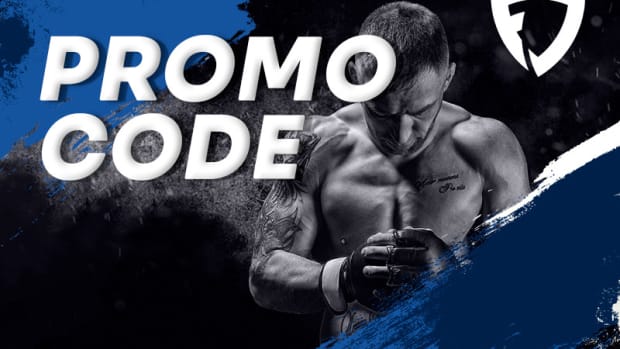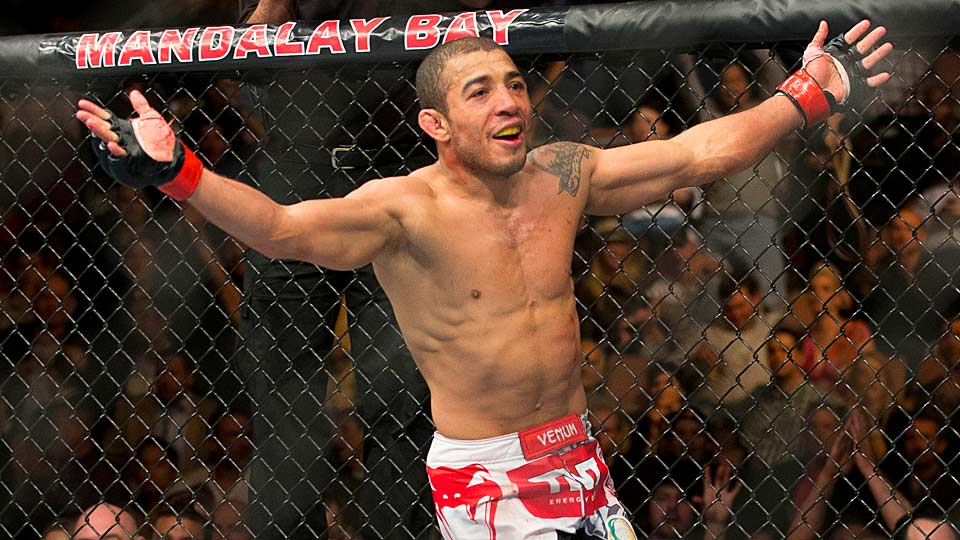
Surplus of events watering down the quality of UFC pay-per-views
When Jon Jones refused to fight in August, 2012, it was the first time in the decade-plus that parent company Zuffa was running the greatest fighting show on earth that an event had to be canceled. A pay-per-view event, no less, headlined by a championship bout featuring a young dynamo who was quickly ascending the pound-for-pound mountain. But said champ wouldn’t accept a short-notice replacement challenger, in part on advice of his trainer, Greg Jackson. What’s still relevant is the vibe of it all: The disappearing act of UFC 151 was a fiasco.
This past Tuesday, less than two years later, the company canceled another PPV, this time between champion Jose Aldo and challenger Chad Mendes. Other than to the fans in southern California — UFC 176 was scheduled for Aug. 2 in Los Angeles — this loss is looking like a win.
Sure, when the ax falls on a marquee event it’s a black eye for the company. But a black eye fades pretty quickly, and the long-range fallout could be a much-needed rethinking of the PPV big picture.
Even with the Aldo vs. Mendes rematch still up in the air — it was an injury to the featherweight champ that necessitated the postponement of the 169 main event with Aldo’s return date still yet to be set — all 10 of the other bouts on the LA card have found new homes. And every time one of them has, it’s fortified a fight card that needed an infusion of new blood.
An example: The co-main event between Ronaldo “Jacare” Souza and Gegard Mousasi, with the winner presumably in position to challenge for the middleweight belt, moves to a Fight Night event Sept. 5 in Uncasville, Conn. It’ll likely be the main event of a what’s shaping up as a killer card. (It’s being shaped that way not coincidentally but surely as a response to the presence of a Bellator event 10 miles away at another Connecticut casino that same night. But that’s a different story.)
So the UFC has counter-programming down. Now how about premium programming?
The fight promotion was built on a PPV-fueled business plan, and it’s stayed the course even as the landscape has shifted. The most successful PPV in company history was UFC 100, a July 2009 event that sold to an estimated 1.6 million homes, according to buy rates published at MMApayout.com. What made that event stand out? Two things: First, its marquee touted not one but two title bouts, featuring a pair of the sport’s biggest draws: heavyweight champ Brock Lesnar and welterweight king Georges St-Pierre. Secondly, the big event came during a time when MMA fans were regularly faced with a choice between forking over cash for a PPV or settling for slim pickings.
Now, some would say today is a time of slim pickings in MMA, too, with the UFC having expanded its schedule globally. Just two weeks ago, the downside of expansion reared its head in New Zealand, where for the first time in its history the UFC headlined a card with a meeting between fighters both riding two-bout losing streaks (Nate Marquardt and James Te Huna). Talk about a slippery slope of downward momentum.
But what critics perceive as a general over-saturation of the sport — the UFC will hold 42 events in 2014, doubling its schedule of five years ago — is only a side issue to a PPV problem. That UFC 100 triumph came during a year when the company held 13 PPVs and averaged nearly 650,000 buys. Sure, the event drawing 1.6 million boosted the average, but according to reported estimates, no PPV that year sold to fewer than 350,000 homes.
This year, that would be the company’s high-water mark, a number reached only by UFC 172, which was headlined by a light heavyweight title fight between Jones and Alexander Gustafsson. Think about that: The greatest fighter on the planet was able to pull in only as many customers as the least appealing pay card from five years ago.
The 2009 events estimated at 350,000: UFC 93, headlined by a bout between a couple of former champs, Rich Franklin and Dan Henderson, and UFC 96, also topped by a non-title fight, this one between Quinton “Rampage” Jackson and Keith Jardine. There’s some star power there, but nothing like “Bones” Jones.
What those 2009 cards had going for them was a relative lack of competition. That’s not a commentary on the strength of rival promotions but rather an observation about the UFC’s own schedule. The company’s slate that year consisted of just 20 fight cards. So other than the 13 PPVs, there were only seven events available on regular cable TV. If you wanted to watch UFC fights, you had to pay nearly two thirds of the time.
In 2014, that’s no longer the case. This year’s schedule was to have the exact same number of PPVs, now down to an even dozen with the 169 cancelation, but between Fox network telecasts, Fox Sports 1 events and Fight Pass presentations, the full event list for the year fills out to 42 cards. That’s 30 options for fans to watch fights without forking over a dime more than the regular cable bill and Fight Pass subscription.
Expansion is running rampant. As recently as two years ago, the UFC schedule was at 32 events, with 18 not on PPV. That was a dramatic increase over ’09, for sure, but a far cry from what we have today. It’s an explosion.
The octagon has paid visits to Singapore, Macau, Abu Dhabi and Auckland already this year, with stops to come in Dublin (next Saturday), Tokyo, Mexico City and Istanbul. Some view this expansion as too much too soon. That might be so. But in a year when PPV buy rates are down across the board and one event, last month’s UFC 174 featuring a Demetrious Johnson flyweight title defense, reportedly sold to just between 95,000 and 125,000 homes, the most immediate concern for the UFC is generating interest among paying customers.
If you’re going to schedule a fight card every eight or nine days — that’s what 43 events over a 365-day calendar year comes down to — you really should be turning your pay events into events. How do you make them stand out for fans who might be happy to just watch the free stuff?
By shining bright objects in the customers’ eyes, like championship belts. When CEO Lorenzo Fertitta was on Fox Sports 1 this week explaining the cancelation of UFC 176, he said something that most observers presumed was true but hadn't been explicitly spoken: The promotion reserves PPVs for title fights. Well, why not go one better? Why not elevate your PPVs far above the rest of the schedule and make them truly worth buying and by putting two title fights on each?
The UFC has nine champions and soon that number will hit 10 when the women’s strawweight tournament crowns a title holder. So even if each champ fights only twice a year that’s 20 title bouts, enough to put two on each of your 10 PPVs.
Ten PPVs? But what happened to Nos. 11, 12 and 13? Well that would be another way to make the pay cards special: Trim the schedule just a bit so the big events don’t come so often. Ten stacked PPVs might generate the same income as the current schedule of 13, with some of them being largely ignored. PPVs should be the fans’ opportunities to watch the brightest stars shine.
The thing is, the UFC has a star-power problem. Lesnar is far off in the distance in the rear-view mirror and St-Pierre is gone, too. Anderson Silva is coming back, but for how long and at what level of effectiveness? We all saw in last weekend’s sad career finale for B.J. Penn what it looks like when the wheels come off. Who among the 400-plus fighters on the UFC roster can be relied upon for the long term? Even the short term is in question.
Heavyweight champion Cain Velasquez hasn’t fought since last October because of injury. Other champs on the shelf are welterweight Johny Hendricks, lightweight Anthony Pettis and now Aldo. Johnson is healthy, but his top challenger, John Dodson, is out. “Mighty Mouse” doesn’t sell PPVs anyway, and we also can’t expect the new 115-pound women’s champ to be a draw. T.J. Dillashaw? The new bantamweight belt holder will probably do OK in the PPV ledger with his rematch with Renan Barão, but would a second win over the man he dethroned establish him?
Questions hover over practically every fighter wearing a shiny brass-and-leather UFC strap, even Jones and crossover star Ronda Rousey. But stacking two of the sport’s champions at the top of each PPV, as the UFC did last weekend with title bouts by Rousey and middleweight Chris Weidman, would make these events special. And then, if the pay card should lose one champ to injury, as so often happens, there’s still a golden ring at stake. The show could go on.
